疲劳驾驶检测和识别3:Android实现疲劳驾驶检测和识别(含源码,可实时检测)
目录
疲劳驾驶检测和识别3:Android实现疲劳驾驶检测和识别(含源码,可实时检测)
1.疲劳驾驶检测和识别方法
2.人脸检测方法
3.疲劳驾驶检测和识别模型训练
4.疲劳驾驶检测和识别模型Android部署
(1) 将Pytorch模型转换ONNX模型
(2) 将ONNX模型转换为TNN模型
(3) Android端上部署模型
(4) Android测试效果
(5) 运行APP闪退:dlopen failed: library "libomp.so" not found
5.项目源码下载
6. C++实现疲劳驾驶检测识别
这是项目《疲劳驾驶检测和识别》系列之《Android实现疲劳驾驶检测和识别(含源码,可实时检测)》,主要分享将Python训练后的疲劳驾驶检测和识别模型,移植到Android平台。我们将开发一个简易的、可实时运行的疲劳驾驶检测和识别的Android Demo。准确率还挺高的,采用轻量级mobilenet_v2模型的疲劳驾驶识别准确率也可以高达97.8682%左右,满足业务性能需求。

项目将手把手教你将训练好的疲劳驾驶检测和识别模型部署到Android平台中,包括如何转为ONNX,TNN模型,并移植到Android上进行部署,实现一个疲劳驾驶检测和识别的Android Demo APP 。APP在普通Android手机上可以达到实时的检测识别效果,CPU(4线程)约30ms左右,GPU约25ms左右 ,基本满足业务的性能需求。
【尊重原创,转载请注明出处】https://blog.csdn.net/guyuealian/article/details/131834970
先展示一下Android版本疲劳驾驶检测和识别Demo效果:
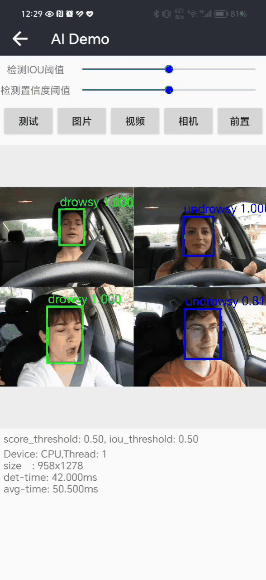
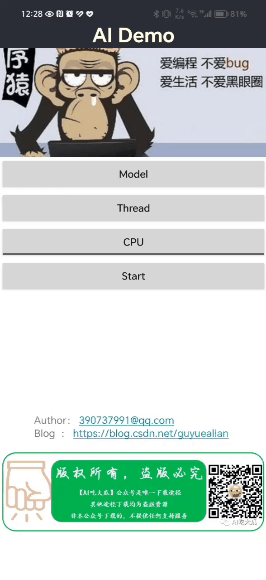
Android疲劳驾驶检测和识别APP Demo体验:https://download.csdn.net/download/guyuealian/88088257
更多项目《疲劳驾驶检测和识别》系列文章请参考:
- 疲劳驾驶检测和识别1: 疲劳驾驶检测和识别数据集(含下载链接)https://blog.csdn.net/guyuealian/article/details/131718648
- 疲劳驾驶检测和识别2:Pytorch实现疲劳驾驶检测和识别(含疲劳驾驶数据集和训练代码)https://blog.csdn.net/guyuealian/article/details/131834946
-
疲劳驾驶检测和识别3:Android实现疲劳驾驶检测和识别(含源码,可实时检测)https://blog.csdn.net/guyuealian/article/details/131834970
-
疲劳驾驶检测和识别4:C++实现疲劳驾驶检测和识别(含源码,可实时检测)https://panjinquan.blog.csdn.net/article/details/131834980
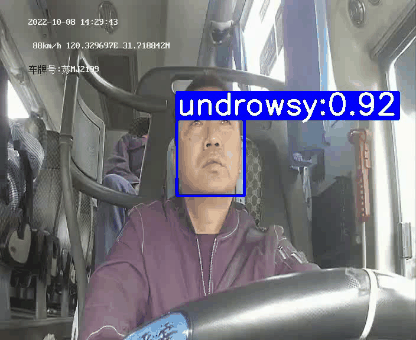
1.疲劳驾驶检测和识别方法
疲劳驾驶检测和识别方法有多种实现方案,这里采用最常规的方法:基于人脸检测+疲劳驾驶分类识别方法,即先采用通用的人脸检测模型,进行人脸检测定位人体区域,然后按照一定规则裁剪人脸检测区域,再训练一个疲劳驾驶行为识别分类器,完成疲劳驾驶检测和识别任务;
这样做的好处,是可以利用现有的人脸检测模型进行人脸检测,而无需重新标注疲劳驾驶的人脸检测框,可减少人工标注成本低;而疲劳驾驶分类数据相对而言比较容易采集,分类模型可针对性进行优化。
2.人脸检测方法
本项目人脸检测训练代码请参考:https://github.com/Linzaer/Ultra-Light-Fast-Generic-Face-Detector-1MB
这是一个基于SSD改进且轻量化后人脸检测模型,很slim,整个模型仅仅1.7M左右,在普通Android手机都可以实时检测。人脸检测方法在网上有一大堆现成的方法可以使用,完全可以不局限我这个方法。

关于人脸检测的方法,可以参考我的另一篇博客:
当然可以基于YOLOv5训练一个人脸检测模型:人脸检测和行人检测2:YOLOv5实现人脸检测和行人检测(含数据集和训练代码)
3.疲劳驾驶检测和识别模型训练
关于疲劳驾驶检测和识别模型的训练方法,请参考本人另一篇博文《疲劳驾驶检测和识别2:Pytorch实现疲劳驾驶检测和识别(含疲劳驾驶数据集和训练代码)》https://blog.csdn.net/guyuealian/article/details/131834946
4.疲劳驾驶检测和识别模型Android部署
目前CNN模型有多种部署方式,可以采用TNN,MNN,NCNN,以及TensorRT等部署工具,鄙人采用TNN进行Android端上部署。部署流程可分为四步:训练模型->将模型转换ONNX模型->将ONNX模型转换为TNN模型->Android端上部署TNN模型。
(1) 将Pytorch模型转换ONNX模型
训练好Pytorch模型后,我们需要先将模型转换为ONNX模型,以便后续模型部署。
- 原始项目提供转换脚本,你只需要修改model_file为你模型路径即可
- convert_torch_to_onnx.py实现将Pytorch模型转换ONNX模型的脚本
python libs/convert/convert_torch_to_onnx.py"""
This code is used to convert the pytorch model into an onnx format model.
"""
import sys
import ossys.path.insert(0, os.getcwd())
import torch.onnx
import onnx
from classifier.models.build_models import get_models
from basetrainer.utils import torch_toolsdef build_net(model_file, net_type, input_size, num_classes, width_mult=1.0):""":param model_file: 模型文件:param net_type: 模型名称:param input_size: 模型输入大小:param num_classes: 类别数:param width_mult::return:"""model = get_models(net_type, input_size, num_classes, width_mult=width_mult, is_train=False, pretrained=False)state_dict = torch_tools.load_state_dict(model_file)model.load_state_dict(state_dict)return modeldef convert2onnx(model_file, net_type, input_size, num_classes, width_mult=1.0, device="cpu", onnx_type="default"):model = build_net(model_file, net_type, input_size, num_classes, width_mult=width_mult)model = model.to(device)model.eval()model_name = os.path.basename(model_file)[:-len(".pth")] + ".onnx"onnx_path = os.path.join(os.path.dirname(model_file), model_name)# dummy_input = torch.randn(1, 3, 240, 320).to("cuda")dummy_input = torch.randn(1, 3, input_size[1], input_size[0]).to(device)# torch.onnx.export(model, dummy_input, onnx_path, verbose=False,# input_names=['input'],output_names=['scores', 'boxes'])do_constant_folding = Trueif onnx_type == "default":torch.onnx.export(model, dummy_input, onnx_path, verbose=False, export_params=True,do_constant_folding=do_constant_folding,input_names=['input'],output_names=['output'])elif onnx_type == "det":torch.onnx.export(model,dummy_input,onnx_path,do_constant_folding=do_constant_folding,export_params=True,verbose=False,input_names=['input'],output_names=['scores', 'boxes', 'ldmks'])elif onnx_type == "kp":torch.onnx.export(model,dummy_input,onnx_path,do_constant_folding=do_constant_folding,export_params=True,verbose=False,input_names=['input'],output_names=['output'])onnx_model = onnx.load(onnx_path)onnx.checker.check_model(onnx_model)print(onnx_path)if __name__ == "__main__":net_type = "mobilenet_v2"width_mult = 1.0input_size = [112, 112]num_classes = 2model_file = "work_space/mobilenet_v2_1.0_CrossEntropyLoss/model/best_model_022_98.1848.pth"convert2onnx(model_file, net_type, input_size, num_classes, width_mult=width_mult)
(2) 将ONNX模型转换为TNN模型
目前CNN模型有多种部署方式,可以采用TNN,MNN,NCNN,以及TensorRT等部署工具,鄙人采用TNN进行Android端上部署
TNN转换工具:
- (1)将ONNX模型转换为TNN模型,请参考TNN官方说明:TNN/onnx2tnn.md at master · Tencent/TNN · GitHub
- (2)一键转换,懒人必备:一键转换 Caffe, ONNX, TensorFlow 到 NCNN, MNN, Tengine (可能存在版本问题,这个工具转换的TNN模型可能不兼容,建议还是自己build源码进行转换,2022年9约25日测试可用)
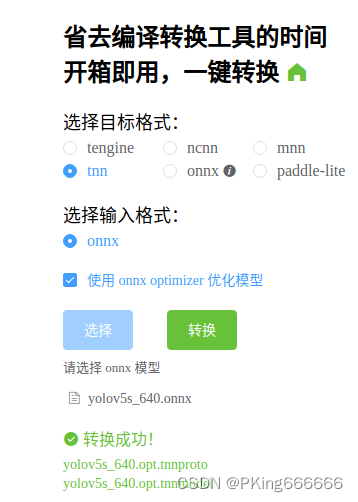
(3) Android端上部署模型
项目实现了Android版本的疲劳驾驶检测和识别Demo,部署框架采用TNN,支持多线程CPU和GPU加速推理,在普通手机上可以实时处理。项目Android源码,核心算法均采用C++实现,上层通过JNI接口调用.
如果你想在这个Android Demo部署你自己训练的分类模型,你可将训练好的Pytorch模型转换ONNX ,再转换成TNN模型,然后把TNN模型代替你模型即可。
- 这是项目Android源码JNI接口 ,Java部分
package com.cv.tnn.model;import android.graphics.Bitmap;public class Detector {static {System.loadLibrary("tnn_wrapper");}/**** 初始化检测模型* @param det_model: 检测模型(不含后缀名)* @param cls_model: 识别模型(不含后缀名)* @param root:模型文件的根目录,放在assets文件夹下* @param model_type:模型类型* @param num_thread:开启线程数* @param useGPU:是否开启GPU进行加速*/public static native void init(String det_model, String cls_model, String root, int model_type, int num_thread, boolean useGPU);/**** 返回检测和识别结果* @param bitmap 图像(bitmap),ARGB_8888格式* @param score_thresh:置信度阈值* @param iou_thresh: IOU阈值* @return*/public static native FrameInfo[] detect(Bitmap bitmap, float score_thresh, float iou_thresh);
}- 这是Android项目源码JNI接口 ,C++部分
#include <jni.h>
#include <string>
#include <fstream>
#include "src/object_detection.h"
#include "src/classification.h"
#include "src/Types.h"
#include "debug.h"
#include "android_utils.h"
#include "opencv2/opencv.hpp"
#include "file_utils.h"using namespace dl;
using namespace vision;static ObjectDetection *detector = nullptr;
static Classification *classifier = nullptr;JNIEXPORT jint JNI_OnLoad(JavaVM *vm, void *reserved) {return JNI_VERSION_1_6;
}JNIEXPORT void JNI_OnUnload(JavaVM *vm, void *reserved) {}extern "C"
JNIEXPORT void JNICALL
Java_com_cv_tnn_model_Detector_init(JNIEnv *env,jclass clazz,jstring det_model,jstring cls_model,jstring root,jint model_type,jint num_thread,jboolean use_gpu) {if (detector != nullptr) {delete detector;detector = nullptr;}std::string parent = env->GetStringUTFChars(root, 0);std::string det_model_ = env->GetStringUTFChars(det_model, 0);std::string cls_model_ = env->GetStringUTFChars(cls_model, 0);string det_model_file = path_joint(parent, det_model_ + ".tnnmodel");string det_proto_file = path_joint(parent, det_model_ + ".tnnproto");string cls_model_file = path_joint(parent, cls_model_ + ".tnnmodel");string cls_proto_file = path_joint(parent, cls_model_ + ".tnnproto");DeviceType device = use_gpu ? GPU : CPU;LOGW("parent : %s", parent.c_str());LOGW("useGPU : %d", use_gpu);LOGW("device_type: %d", device);LOGW("model_type : %d", model_type);LOGW("num_thread : %d", num_thread);ObjectDetectionParam model_param = FACE_MODEL;detector = new ObjectDetection(det_model_file,det_proto_file,model_param,num_thread,device);//ClassificationParam ClassParam = FACE_MASK_MODEL;ClassificationParam ClassParam = DROWSY_MODEL;classifier = new Classification(cls_model_file,cls_proto_file,ClassParam,num_thread,device);
}extern "C"
JNIEXPORT jobjectArray JNICALL
Java_com_cv_tnn_model_Detector_detect(JNIEnv *env, jclass clazz, jobject bitmap,jfloat score_thresh, jfloat iou_thresh) {cv::Mat bgr;BitmapToMatrix(env, bitmap, bgr);int src_h = bgr.rows;int src_w = bgr.cols;// 检测区域为整张图片的大小FrameInfo resultInfo;// 开始检测if (detector != nullptr) {detector->detect(bgr, &resultInfo, score_thresh, iou_thresh);} else {ObjectInfo objectInfo;objectInfo.x1 = 0;objectInfo.y1 = 0;objectInfo.x2 = (float)src_w;objectInfo.y2 = (float)src_h;objectInfo.label = 0;resultInfo.info.push_back(objectInfo);}int nums = resultInfo.info.size();LOGW("object nums: %d\n", nums);if (nums > 0) {// 开始检测classifier->detect(bgr, &resultInfo);// 可视化代码//classifier->visualizeResult(bgr, &resultInfo);}//cv::cvtColor(bgr, bgr, cv::COLOR_BGR2RGB);//MatrixToBitmap(env, bgr, dst_bitmap);auto BoxInfo = env->FindClass("com/cv/tnn/model/FrameInfo");auto init_id = env->GetMethodID(BoxInfo, "<init>", "()V");auto box_id = env->GetMethodID(BoxInfo, "addBox", "(FFFFIF)V");auto ky_id = env->GetMethodID(BoxInfo, "addKeyPoint", "(FFF)V");jobjectArray ret = env->NewObjectArray(resultInfo.info.size(), BoxInfo, nullptr);for (int i = 0; i < nums; ++i) {auto info = resultInfo.info[i];env->PushLocalFrame(1);//jobject obj = env->AllocObject(BoxInfo);jobject obj = env->NewObject(BoxInfo, init_id);// set bbox//LOGW("rect:[%f,%f,%f,%f] label:%d,score:%f \n", info.rect.x,info.rect.y, info.rect.w, info.rect.h, 0, 1.0f);env->CallVoidMethod(obj, box_id, info.x1, info.y1, info.x2 - info.x1, info.y2 - info.y1,info.category.label, info.category.score);// set keypointfor (const auto &kps : info.landmarks) {//LOGW("point:[%f,%f] score:%f \n", lm.point.x, lm.point.y, lm.score);env->CallVoidMethod(obj, ky_id, (float) kps.x, (float) kps.y, 1.0f);}obj = env->PopLocalFrame(obj);env->SetObjectArrayElement(ret, i, obj);}return ret;
}(4) Android测试效果
Android Demo在普通手机CPU/GPU上可以达到实时检测和识别效果;CPU(4线程)约30ms左右,GPU约25ms左右 ,基本满足业务的性能需求。


(5) 运行APP闪退:dlopen failed: library "libomp.so" not found
参考解决方法:
解决dlopen failed: library “libomp.so“ not found_PKing666666的博客-CSDN博客_dlopen failed
Android SDK和NDK相关版本信息,请参考:

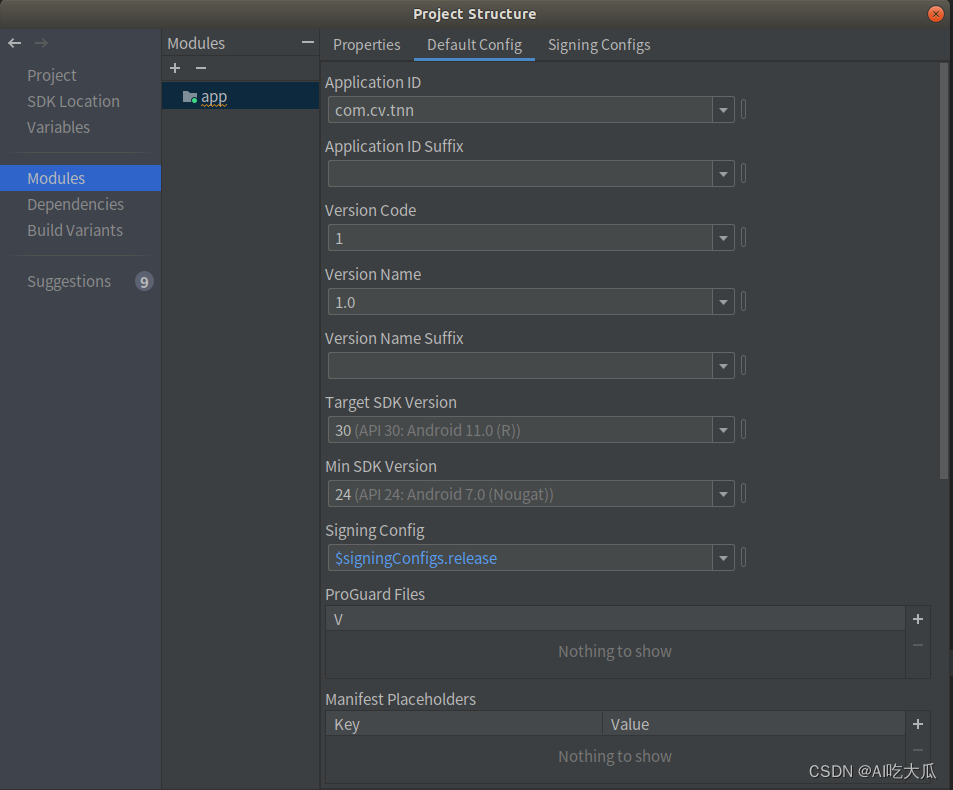
5.项目源码下载
Android项目源码下载地址:疲劳驾驶检测和识别3:Android实现疲劳驾驶检测和识别(含源码,可实时检测)
整套Android项目源码内容包含:
- 提供Android版本的人脸检测模型
- 提供整套疲劳驾驶检测和识别Android Demo源码
- Android Demo在普通手机CPU/GPU上可以实时检测和识别,约30ms左右
- Android Demo支持图片,视频,摄像头测试
- 所有依赖库都已经配置好,可直接build运行,若运行出现闪退,请参考dlopen failed: library “libomp.so“ not found 解决。
Android疲劳驾驶检测和识别APP Demo体验:https://download.csdn.net/download/guyuealian/88088257
如果你需要疲劳驾驶检测和识别的训练代码,请参考:《疲劳驾驶检测和识别2:Pytorch实现疲劳驾驶检测和识别(含疲劳驾驶数据集和训练代码)》https://blog.csdn.net/guyuealian/article/details/131834946
6. C++实现疲劳驾驶检测识别
参考文章:疲劳驾驶检测和识别4:C++实现疲劳驾驶检测和识别(含源码,可实时检测)https://panjinquan.blog.csdn.net/article/details/131834980









)




)




